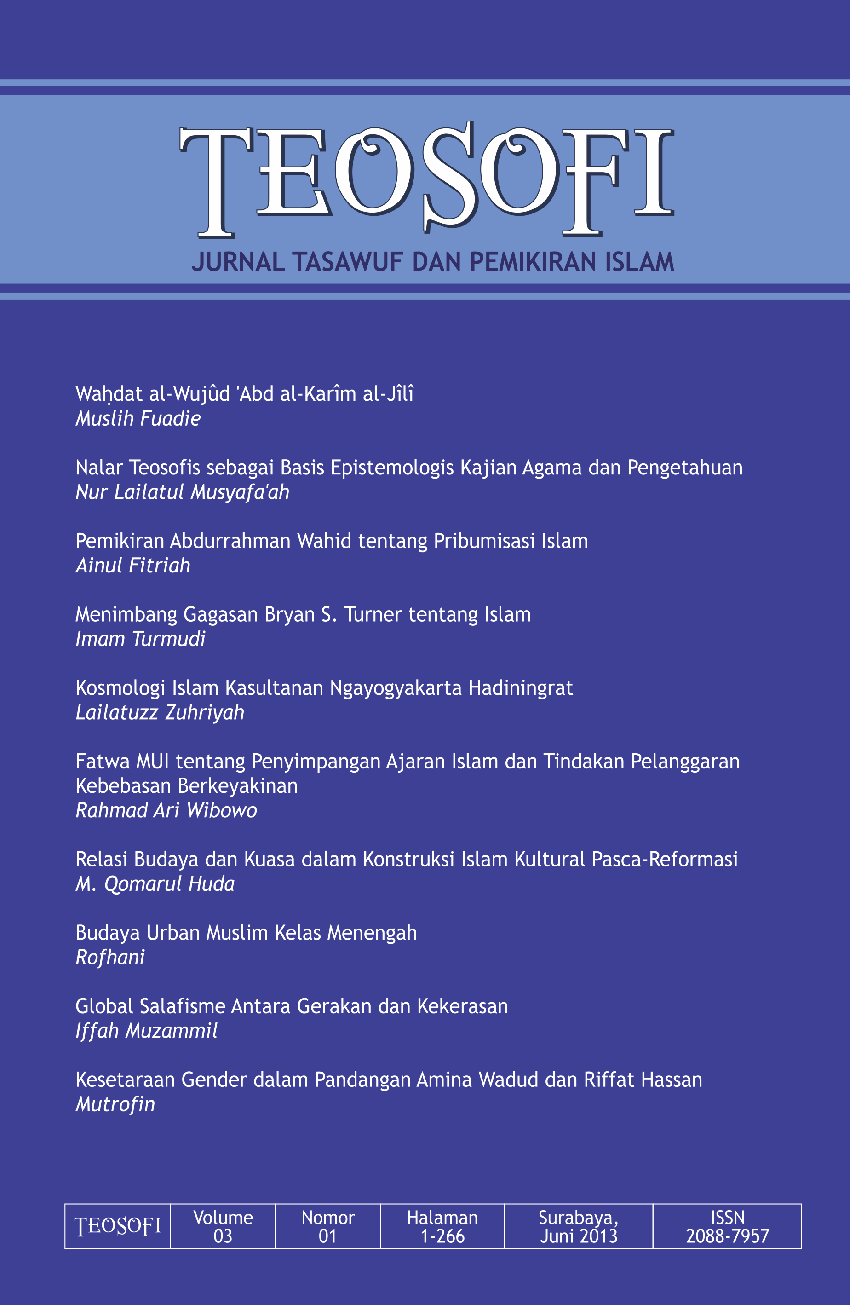Global Salafisme antara Gerakan dan Kekerasan
Main Article Content
Abstract
This article explores Salafism movement between ideology and violence. Categorically, salafi movement can be categorized in two forms. First, salafi. This group berorintasi the purification of faith to make improvements through individual, family, and community structure. Second, salafi jihadi. Although this group also aims to purification, but this group tends to be politically, do not even hesitate to commit violence. However, they both have the desire to realize a people as a form of community of believers. In the end, according to Bernard Haykel, Salafism least understood of the three basic constitution. First, theology embodied in the doctrine of monotheism. In matters of theology, all members of this movement looks unanimously agreed. Second, the law, which pivots on the issue of ijtihad. Although there are differences in attitude, but most of the salafi found ijtihad is a necessity, while taqlîd should be avoided, even by Muslims who are not educated though. Third, the political, which is determined by the methodology of their choice to realize the desire involved in the international arena.
Downloads
Article Details
Licensing
© The Author(s). Published by Department of Aqidah and Islamic Philosophy, Faculty of Ushuluddin and Philosophy, Sunan Ampel State Islamic University Surabaya, Indonesia.
This is an Open Access article distributed under the terms of Attribution-NonCommercial 4.0 International (CC BY-NC 4.0).
References
Abdalla, Ulil Abshar. “Pidato Kebudayaan” dalam http://www.apakabar.ws/content/view/3039/8888889/Diakses 12 November 2010.
Abdullah, Amin. “Filsafat Pendidikan Muhammadiyah Berbasis Islamic Studies Tingkat Kesarjanaan” dalam http:/aminabd.wordpress .com/2010/06/16/Filsafat Pendidikan Muhammadiyah Berbasis Islamic Studies Tingkat Kesarjanaan/diakses tgl 6 November 2010.
Abdullah, Amin. Kuliah Metodologi Studi Islam, Pascasarjana IAIN Sunan Ampel Surabaya, 10 Januari 2011.
Asbuhî (al), Mâlik b. Anas Abû ‘Abd Allâh. Muwattâ‘ al-Imâm Mâlik, Vol. 3. Damaskus: Dâr al-Qalam, 1991.
Asy-Syaukani, Luthfi. “Salafisme: Asal-Usul dan Perkembangannya” dalam http://www.nusantaraonline.org/id/content/salafisme-asal-usul-dan-perkembangannya.
Azra, Azyumardi. “Fenomena Fundamentalisme dalam Islam: Survey Historis dan Doktrinal” dalam Jurnal Ilmu dan Kebudayaan Ulumul Qur’an, No. 3, Vol. IV, 1993.
Baihaqî (al), Abû Bakr Ahmad b al-Husain b ‘Alî. al-Sunan al-Kubrâ, Vol. 10. Hyderabad: Majlis Dâirah al-Ma‘ârif al-Nizâmîyah, 1344.
Bernard Haykel, “On the Nature of Salafi Thought and Action”, dalam Roel Meijer (ed.), Global Salafism. London: Hurts and Company, 2009.
Ed Husain, Matinya Semangat Jihad, terj. A Malik. Tangerang: Pustaka Alvabet, 2008.
Hamid, Sadek. “The Attraction of Authentic Islam” dalam Global Salafism, 385-386.
Hasan, Noorhaidi. Melacak Akar Salafisme Radikal di Indonesia, http://www.nusantaraonline.org/id/content/melacak-akar-salafis me-radikal-di-indonesia-dinamika-islam-transnational-dalam-pergul atan
http://en.wikipedia.org/wiki/salafist-jihadism
http://harmanza.wordpress.com/2010/06/30/perbedaan-salafi-dan-salafi -jihadi.
http://telagahikmah.org/id/index.php?option=com_content&task=view&id=190&Itemid=1
http://www.ranesi.nl/arsipaktua/indonesia060905/penangkapan gembon g gam071001
Husain, Ed. The Islamist. London: Penguin Books, 2007.
Khalimi. Ormas-ormas Islam. Jakarta: GP Press, 2010.
Madjid, Nurcholis. Kaki Langit Peradaban Islam. Jakarta: Paramadina, 1997.
Meijer, Roel. “Introduction”, dalam Global Salafism. London: Hurst and Company, 2009.
Schwartz, Stephen Sulaiman. Dua Wajah Islam: Moderatisme dan Fundamentalisme dalam Wacana Global, terj. Hodri Ariev. Jakarta: The Wahid Institute, 2007.
Wagamakers, Joas. “The Transformation of a Radical Concept al-wala’ wa al-bara’” dalam Global Salafism.

